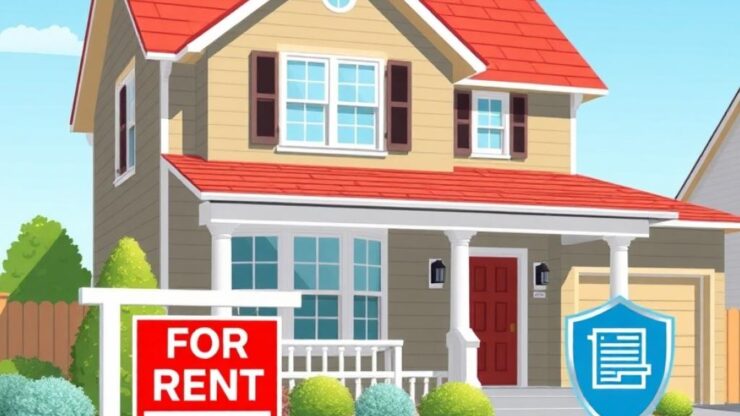Understanding Landlord Insurance Basics
The Importance of Landlord Insurance
As a rental property owner, navigating the complexities of insurance can be daunting yet crucial for protecting your investment. Landlord insurance serves as a safety net, providing essential coverage that addresses the unique risks associated with renting out properties. This article delves into the fundamentals of landlord insurance, equipping you with the knowledge necessary to safeguard your assets and ensure peace of mind.
Types of Coverage Offered
Landlord insurance typically encompasses various coverage options tailored to the needs of property owners. Understanding these options is vital for selecting the right policy that aligns with your specific circumstances. Below is a breakdown of the most common types of coverage included in landlord insurance:
- Property Damage Protection: Covers damages to the physical structure of your rental property caused by natural disasters, vandalism, or other covered perils.
- Liability Coverage: Protects you in the event that a tenant or visitor is injured on your property and holds you legally responsible.
- Loss of Rental Income: Compensates for lost income if your property becomes uninhabitable due to a covered event, ensuring financial stability during repairs.
- Contents Coverage: Covers personal property within the rental unit, such as appliances and furniture, against theft or damage.
Choosing the Right Policy
Selecting the appropriate landlord insurance policy involves careful consideration of your property type, location, and specific risks. Begin by evaluating the unique features of your rental property. For instance, properties in high-risk areas may require additional coverage. Consulting with an insurance professional can also provide insights into policy options that meet your needs and budget. Moreover, comparing quotes from multiple insurers can yield significant savings and ensure comprehensive coverage.
Key Coverages for Property Protection
For landlords, understanding the specific coverages available in landlord insurance is paramount for ensuring the protection of their rental investments. Each coverage type addresses particular risks, providing a comprehensive shield against unforeseen circumstances that could jeopardize your property and financial stability. Below, we explore the most critical coverages that every property owner should consider when selecting a landlord insurance policy.
Comprehensive Property Damage Coverage
Property damage coverage is fundamental for safeguarding the physical structure of your rental home. This coverage not only protects against common perils like fire or theft but also extends to natural disasters, which can devastate your investment. In high-risk areas, having robust property damage coverage is not just advisable; it’s often essential. Knowing that your property can be repaired or rebuilt without crippling financial strain offers peace of mind.
Liability Protection: A Necessity for Landlords
Liability protection is crucial for any landlord, as it shields you from legal claims arising from injuries that occur on your property. Whether a tenant slips and falls or a visitor is injured due to a maintenance issue, liability coverage can cover legal fees and medical expenses. Given the potential costs associated with lawsuits, investing in adequate liability insurance is not merely a precaution—it’s a necessity for responsible property management.
Loss of Rental Income: Financial Security During Repairs
In the event that your rental property becomes uninhabitable due to a covered loss, having loss of rental income coverage can be a financial lifesaver. This provision ensures that you continue to receive income even while repairs are underway. It is particularly beneficial during extensive restoration processes that can take time and disrupt your cash flow. Understanding the terms and conditions of this coverage will help you avoid gaps in income during challenging times.
To summarize, the following are key coverages every landlord should consider when evaluating their insurance options:
- Property Damage Coverage: Protects against physical damage to the structure.
- Liability Protection: Covers legal claims from injuries on the property.
- Loss of Rental Income: Compensates for lost rent during repairs.
By ensuring comprehensive coverage in these areas, landlords can confidently manage their properties and mitigate potential risks effectively.
Liability Coverage: Safeguarding Against Tenant Claims
The Crucial Role of Liability Coverage
As a landlord, your primary goal is to provide a safe and comfortable living environment for your tenants. However, despite your best efforts, accidents can occur, leading to potential liability claims. Liability coverage in your landlord insurance policy serves as a critical line of defense against these claims, safeguarding your financial interests and ensuring that you are not left vulnerable to unexpected legal challenges.
Understanding the Scope of Liability Protection
Liability coverage is designed to protect landlords from legal obligations that may arise if a tenant or visitor suffers an injury on the property. This includes incidents such as slips and falls, injuries caused by faulty maintenance, or accidents related to common areas. Here’s a comprehensive look at the various components of liability coverage that every landlord should consider:
- Legal Fees: Covers the costs associated with defending against lawsuits, including attorney fees and court costs.
- Medical Expenses: Pays for medical bills if a tenant or visitor is injured on the property, regardless of fault.
- Settlements and Judgments: Provides financial support for any settlements or judgments awarded to the injured party.
Evaluating Your Liability Coverage Needs
Determining the right amount of liability coverage requires careful consideration of several factors, including the type of property you own, its location, and the demographics of your tenants. Below are key steps to help you assess your liability coverage requirements:
- Assess Risk Factors: Analyze potential hazards associated with your property. Properties with swimming pools, playgrounds, or older building structures may require higher liability limits.
- Review Tenant Demographics: Consider the age and lifestyle of your tenants. Families with young children or elderly tenants may increase the likelihood of accidents.
- Consult Insurance Professionals: Engage with insurance agents who specialize in landlord policies to gain insights into appropriate coverage limits and options tailored to your situation.
By understanding the scope of your liability coverage and evaluating your specific needs, you can protect yourself from the financial ramifications of unforeseen tenant claims. Adopting a proactive approach to managing liability risk not only safeguards your investment but also enhances the overall safety of your rental property.
Evaluating Policy Options and Costs
As a rental property owner, making informed decisions about landlord insurance is vital to securing your investment. With a plethora of insurance providers and policy options available, it can be overwhelming to determine which plan best suits your needs. This section will guide you through the evaluation process, focusing on key factors that influence both policy options and costs, ensuring you make the right choice for your rental properties.
Assessing Coverage Needs and Budget Constraints
Before diving into the specifics of policy options, it’s crucial to assess your coverage needs based on your rental property’s unique attributes. Consider factors such as location, property type, and potential risks to determine the extent of coverage necessary. For instance, properties located in areas prone to natural disasters may warrant additional coverage, which can influence overall costs. Additionally, establishing a clear budget will help you navigate various options without overspending. Understanding your financial limits is key to avoiding costly mistakes.
Comparing Policy Features and Premiums
Once you have a grasp on your coverage requirements and budget, the next step is to compare the features and premiums of different insurance policies. Many insurers offer customizable plans, allowing you to tailor your coverage to fit your specific situation. When evaluating quotes, consider key aspects such as deductibles, coverage limits, and exclusions. It’s essential to carefully read the fine print to avoid unexpected gaps in coverage that could leave you vulnerable in times of need. Some providers may offer discounts for bundling policies or maintaining a claims-free history, which can further influence the overall cost of your premium.
| Policy Feature | Provider A | Provider B | Provider C |
|---|---|---|---|
| Property Damage Coverage | $300,000 | $250,000 | $350,000 |
| Liability Coverage | $1,000,000 | $500,000 | $1,500,000 |
| Loss of Rental Income | 12 months | 6 months | 12 months |
| Annual Premium | $1,200 | $900 | $1,500 |
By organizing the comparisons in a structured manner, you can easily identify the strengths and weaknesses of each policy. This comparative analysis not only helps in selecting the most suitable insurance but also aids in financial planning.
Consulting with Insurance Professionals
After gathering and comparing policy options, it may be beneficial to consult with insurance professionals who specialize in landlord insurance. Their expertise can provide valuable insights into the nuances of different plans and help you make a more informed decision. They can also assist in negotiating terms with providers to ensure you receive the best possible coverage at a competitive rate. Ultimately, leveraging professional guidance can streamline the selection process and enhance your understanding of the insurance landscape.
Common Exclusions in Landlord Insurance
While landlord insurance provides crucial protection for property owners, it is equally important to be aware of the common exclusions that may exist within these policies. Understanding these exclusions can help you avoid unexpected financial burdens and ensure that you have the right supplementary coverage in place to protect your investment fully. Here, we explore some prevalent exclusions that landlords should consider when selecting their insurance policies.
Natural Disasters: The Fine Print
Many landlords are surprised to discover that certain natural disasters may not be covered under standard landlord insurance policies. While property damage coverage is designed to protect against various perils, exclusions often apply to events such as floods, earthquakes, and landslides. To mitigate risk, landlords in vulnerable areas should consider purchasing additional coverage or separate policies specifically tailored for these natural disasters. This proactive approach can help prevent significant financial loss in the event of unforeseen circumstances.
Maintenance Issues: A Landlord’s Responsibility
Another common exclusion in landlord insurance pertains to damages resulting from poor maintenance or neglect. Insurers typically expect property owners to maintain their properties adequately, and any claims resulting from a lack of maintenance may be denied. For instance, if a roof leaks due to a lack of timely repairs, the resulting damage may not be covered. Landlords must prioritize regular inspections and timely maintenance of their properties to minimize risks and ensure that they remain compliant with their insurance policies.
Tenant-Related Incidents: Limits of Coverage
Landlord insurance also has limitations when it comes to tenant-related incidents. For example, while liability coverage protects against injuries to visitors, it may not cover injuries sustained by tenants themselves. Additionally, damages caused deliberately by tenants, such as vandalism or unauthorized alterations to the property, are typically excluded. To safeguard against these risks, landlords may consider requiring renters insurance as part of the lease agreement, which can provide additional protection for tenant-related incidents.
In summary, being aware of the common exclusions in landlord insurance is essential for effective property management. By understanding these limitations, property owners can take proactive steps to secure the necessary additional coverage and maintain their investments effectively. Prioritizing maintenance, considering supplementary policies, and fostering clear communication with tenants will enhance the protection of your rental property.
Disclaimer
This article has been created or edited with the support of artificial intelligence and is for informational purposes only. The information provided should not be considered investment advice. Please seek the support of a professional advisor before making any investment decisions.






